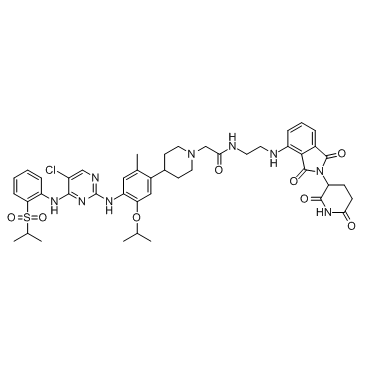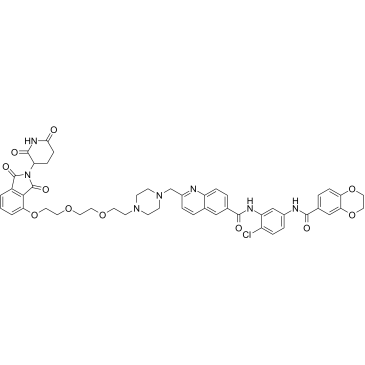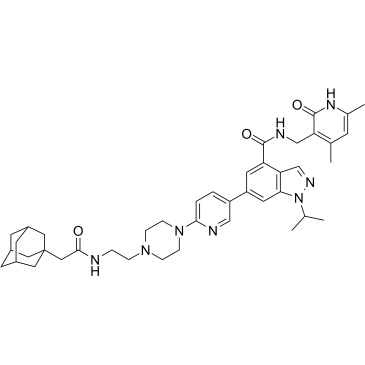 To enhance service speed and avoid tariff delays, we've opened a US warehouse. All US orders ship directly from our US facility.
To enhance service speed and avoid tariff delays, we've opened a US warehouse. All US orders ship directly from our US facility.
| Cat. No. | Product Name | Field of Application | Chemical Structure |
|---|---|---|---|
| DC50141 | SB1-G-187 |
SB1-G-187, a PROTAC, is a multi-kinase degrader.
More description
|

|
| DC50139 | PROTAC HSP90 degrader BP3 |
PROTAC HSP90 degrader BP3 is a potent and selective degradation of HSP90 in a CRBN-dependent fashion. PROTAC HSP90 degrader BP3 has a certain certain degradation effect on HSP90 protein in MCF-7 cells (DC50=0.99 µM). PROTAC HSP90 degrader BP3 inhibits the growth of breast cancer cell.
More description
|

|
| DC50138 | PROTAC ERα Y537S degrader-1 |
PROTAC ERα Y537S degrader-1 comprises a ubiquitin E3 ligase binding group, a linker and a protein binding group. PROTAC ERα Y537S degrader-1 extracts from patent WO2021143822, example 12. PROTAC ERα Y537S degrader-1 is an estrogen receptor-alpha (ERα) Y537S degrader.
More description
|

|
| DC50137 | MI-389 |
MI-389 is a PROTAC translation termination factor GSPT1 degrader. MI-389 disrupts a target that is a shared dependency in different AML and ALL cell lines, and that MI-389 action is dependent on the CRL4CRBN E3 ligase.
More description
|

|
| DC50136 | PROTAC AR-V7 degrader-1 |
PROTAC AR-V7 degrader-1 (Compound 6) is a potent, orally bioavailable and selective AR-V7 degrader with the DC50 of 0.32 µM by recruiting VHL E3 ligase to Androgen receptor (AR) DNA binding domain (DBD) binder. PROTAC AR-V7 degrader-1 exhibits activity against 22Rv1 cell-line expressing AR-V7 with the EC50 of 0.88 µM.
More description
|

|
| DC50135 | PROTAC EGFR degrader 2 |
PROTAC EGFR degrader 2 is a potent PROTAC EGFR degrader. PROTAC EGFR degrader 2 exhibits excellent antiproliferative activity with IC50 of 4.0 nM and good EGFR degradation activity with DC50 of 36.51 nM. PROTAC EGFR degrader 2 can be used for the synthesis of nitroreductase (NTR)-responsive PROTAC.
More description
|

|
| DC50073 | (S,R,S)-AHPC-PEG3-NH2 hydrochloride(E3 ligase Ligand-Linker Conjugates 5) Featured |
(S,R,S)-AHPC-PEG3-NH2 hydrochloride is a synthesized E3 ligase ligand-linker conjugate that incorporates the (S,R,S)-AHPC based VHL ligand and 3-unit PEG linker used in PROTAC technology.
More description
|

|
| DC50072 | (S,R,S)-AHPC-PEG3-NH2 (E3 ligase Ligand-Linker Conjugates 5) Featured |
(S,R,S)-AHPC-PEG3-NH2 is a synthesized E3 ligase ligand-linker conjugate that incorporates the (S,R,S)-AHPC based VHL ligand and 3-unit PEG linker used in PROTAC technology.
More description
|

|
| DC50064 | (S,R,S)-AHPC-C10-NH2 (VH032-C10-NH2) Featured |
(S,R,S)-AHPC-C10-NH2 (VH032-C10-NH2) is a synthesized E3 ligase ligand-linker conjugate that incorporates the (S,R,S)-AHPC based VHL ligand and a linker used for BET-Targeted PROTAC.
More description
|

|
| DC50061 | Pomalidomide-C2-NH2(E3 ligase Ligand 17) Featured |
E3 ligase Ligand 17 is a ligand for E3 ubiquitin ligase. E3 ligase Ligand 17 can be connected to the ligand for protein by a linker to form PROTACs or SNIPERs. PROTACs are inducers of ubiquitination-mediated degradation of cancer-promoting proteins[1].
More description
|

|
| DC50056 | Thalidomide-PEG2-C2-NH2 Featured |
Thalidomide-PEG2-C2-NH2 is a synthesized E3 ligase ligand-linker conjugate that incorporates the Thalidomide based cereblon ligand and 2-unit PEG linker used in PROTAC technology.
More description
|

|
| DC50055 | Thalidomide-NH-C6-NH2 Featured |
Thalidomide-NH-C6-NH2 is a synthesized E3 ligase ligand-linker conjugate that incorporates the Thalidomide based cereblon ligand and a linker used in PROTAC technology.
More description
|

|
| DC50053 | E3 Ligase Ligand-Linker Conjugates 20 Featured |
Thalidomide-O-amido-C8-NH2 (Cereblon Ligand-Linker Conjugates 2), a synthesized E3 ligase ligand-linker conjugate that incorporates the Thalidomide based cereblon ligand and a linker, can be used in the synthesis of PROTACs.
More description
|

|
| DC50071 | (S,R,S)-AHPC-PEG2-NH2 hydrochloride E3 ligase Ligand-Linker Conjugates 6) Featured |
(S,R,S)-AHPC-PEG2-NH2 hydrochloride (VH032-PEG2-NH2 hydrochloride) is a synthesized E3 ligase ligand-linker conjugate that incorporates the (S,R,S)-AHPC based VHL ligand and 2-unit PEG linker used in the synthesis of PROTACs.
More description
|

|
| DC21351 | MS4078 Featured |
MS4078 is a novel PROTAC (degrader) of ALK, potently decreases cellular levels of oncogenic active ALK fusion proteins in a concentration- and time-dependent manner in SU-DHL-1 lymphoma and NCI-H2228 lung cancer cells (DC50=11 nM).
More description
|

|
| DC11679 | CCT-367766 Featured |
CCT367766 is a potent and the third generation heterobifunctional and PROTAC-based pirin targeting protein degradation probe (PDP), depletes pirin protein expression at low concentration. CCT367766 exhibits a moderate affinity for the CRBN-DDB1 complex with an IC50 value of 490 nM. CCT367766 reveals a good affinity for the recombinant pirin and CRBN with Kd values of 55 nM and 120 nM, respectively. CCT367766 provides a potential chemical tool to study a largely unexplored protein[1].
More description
|

|
| DC26169 | MS1943 Featured |
MS1943 is a first-in-class, orally bioavailable EZH2 selective degrader, with an IC50 of 120 nM. MS1943 significantly reduces EZH2 protein levels in numerous triple-negative breast cancer (TNBC) and other cancer and noncancerous cell lines.
More description
|

|
| DC49373 | Thiol-PEG3-acetic acid |
Thiol-PEG3-acetic acid is a PEG-based PROTAC linker that can be used in the synthesis of PROTACs.
More description
|

|
| DC49364 | PROTAC Bcl-xL degrader-3 |
PROTAC Bcl-xL degrader-3 is a potent ROTAC Bcl-xL degrader (WO2020163823A2, compound 44).
More description
|

|
| DC49320 | Bromo-PEG2-acetic acid |
Bromo-PEG2-acetic acid is a PEG-based PROTAC linker that can be used in the synthesis of PROTACs.
More description
|

|
| DC49309 | PhosTAC7 |
Similar to PROTACs in their ability to induce ternary complexes, PhosTAC7 focuses on recruiting a Ser/Thr phosphatase to a phosphosubstrate to mediate its dephosphorylation.
More description
|

|
| DC49270 | DBCO-N-bis(PEG4-NHS ester) |
DBCO-N-bis(PEG4-NHS ester) is a PEG linker which contains two PEG4-NHS ester and a DBCO group. DBCO-N-bis(PEG4-NHS ester) is useful for protein modification or labeling.
More description
|

|
| DC49266 | ZXH-4-130 TFA |
ZXH-4-130 TFA is a highly potent and selective degrader of CRBN. ZXH-4-130 is a CRBN-VHL compound (hetero-PROTAC).
More description
|

|
| DC49260 | C18-PEG13-acid |
C18-PEG13-acid is a PEG-based PROTAC linker that can be used in the synthesis of PROTACs.
More description
|

|
| DC49252 | PROTAC ER Degrader-10 |
PROTAC ER Degrader-10 is a potent PROTAC ER degrader and can be used for cancer research. PROTAC ER Degrader-10 is extracted from patent WO2021133886, example 36.
More description
|

|
| DC49245 | PROTAC BRD9 Degrader-4 |
PROTAC BRD9 Degrader-4 is a BRD9 bifunctional degrader for treating cancer.
More description
|

|
| DC49232 | PROTAC BRD9 Degrader-3 |
PROTAC BRD9 Degrader-3 is a BRD9 bifunctional degrader for treating cancer.
More description
|

|
| DC49231 | SJ10542 |
SJ10542 is a potent and selective JAK2/3 directing phenyl glutarimide (PG)-PROTAC with DC50s of 14, 11, and 24 nM for JAK2, JAK3, and JAK2-fusion ALL, respectively. SJ10542 utilizes a PG ligand as the cereblon (CRBN) recruiter.
More description
|

|
| DC49213 | Mal-amido-PEG15-acid |
Mal-amido-PEG15-acid is a PEG-based PROTAC linker that can be used in the synthesis of PROTACs.
More description
|

|
| DC49209 | HDAC6 degrader-1 |
HDAC6 degrader-1 is a PROTAC that comprises a selective HDAC6 inhibitor Nexturastat A (Nex A) as the HDAC6 binder, a linker and a ligand for recruiting E3 ligase. HDAC6 degrader-1 induces significant degradation of HDAC6, exhibits excellent selectivity against other HDACs, and demonstrates efficient inhibition of cell proliferation.
More description
|

|